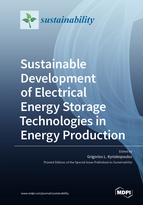Sustainable Development of Electrical Energy Storage Technologies in Energy Production
A special issue of Sustainability (ISSN 2071-1050). This special issue belongs to the section "Energy Sustainability".
Deadline for manuscript submissions: closed (30 September 2018) | Viewed by 94238
Special Issue Editor
Interests: engineering; environment; energy; renewable energy sources; waste management from organic pollutants; properties of polymer materials; business administration; education; culture; human resource management; psychology; urban and regional development; forest resource management; extroversion and internationalization of small and medium enterprises (SMEs); development economics; environmental systems; circular economy; behavioral ecology
Special Issues, Collections and Topics in MDPI journals
Special Issue Information
Dear Colleagues,
Nowadays, energy production increase has been proven a globally contentious issue, as it counts variable stakeholders of competitive interests. Such indicative competitive interests are land use for energy crops against maximizing agricultural production yields, as well as the gradually localized trend of energy production from renewables, compared to the central overexploitation of fossil-fuelled energy sources in mainland grids of energy production. In response to this multi-parametric contradiction on traditional and novel approaches of energy production, this Special Issue aims at attracting researchers whose scientific interest resides in the electrical energy storage (EES) systems in a wide range of applicability: Technological advancements, environmental impacts, economies of scale achievement, active involvement of renewables in EES technologies, socio-economic impacts upon EES diffusion in regional and globalized contexts of analysis. The main limitations and the challenges derived from these scientific approaches will formulate a fresher scientific viewpoint of novel insights upon EES applicability in developed and developing economies, accordingly. Papers selected for this Special Issue are subject to a rigorous peer review procedure, enabling an integrated manner of dissemination upon research advancements and multi-disciplinary dynamics, accordingly.
Dr. Grigorios L. Kyriakopoulos
Guest Editor
Manuscript Submission Information
Manuscripts should be submitted online at www.mdpi.com by registering and logging in to this website. Once you are registered, click here to go to the submission form. Manuscripts can be submitted until the deadline. All submissions that pass pre-check are peer-reviewed. Accepted papers will be published continuously in the journal (as soon as accepted) and will be listed together on the special issue website. Research articles, review articles as well as short communications are invited. For planned papers, a title and short abstract (about 100 words) can be sent to the Editorial Office for announcement on this website.
Submitted manuscripts should not have been published previously, nor be under consideration for publication elsewhere (except conference proceedings papers). All manuscripts are thoroughly refereed through a single-blind peer-review process. A guide for authors and other relevant information for submission of manuscripts is available on the Instructions for Authors page. Sustainability is an international peer-reviewed open access semimonthly journal published by MDPI.
Please visit the Instructions for Authors page before submitting a manuscript. The Article Processing Charge (APC) for publication in this open access journal is 2400 CHF (Swiss Francs). Submitted papers should be well formatted and use good English. Authors may use MDPI's English editing service prior to publication or during author revisions.
Keywords
- electrical energy storage
- sustainability assessment and policies
- energy production
- renewables dynamics
- economies of scale
- environmental sustainability
- socio-economic impact of energy production
- multi-disciplinary energy issues
- land biodiversity






